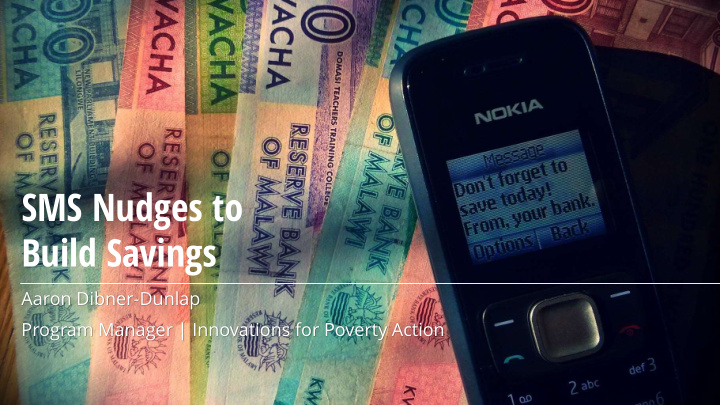



SMS Nudges to Build Savings Aaron Dibner-Dunlap Program Manager | Innovations for Poverty Action
Agenda Background & research questions Summary of field research Prelim. results & lessons learned
Limited Attention A Barrier to Savings We have limited bandwidth to prioritize demands on money (Karlan et al., 2015) • We pay more attention to everyday expenses, like food • We pay less attention to “extraordinary” expenses, like: Predictable but infrequent Rent, loan payment Predictable but distant New child, house purchase Unpredictable Repairs, medical bills We may inadequately save as a result
Mobile Phone Messages can Overcome Biases Immediate o 89% of all SMS are read within 3 minutes Timely o Focuses attention at crucial moments Informative o Efficiently provide information Interactive o Interaction creates relationship Image credit: Flickr user blackbeltjones
What does it look like to evaluate SMS campaigns? Hi Pooja, don’t Hi Pooja, don’t Dear client, Dear client, forget to save! forget to save don’t forget to don’t forget to Thanks for using for predictable save! Thanks for save for our bank. expenses like using our bank. predictable rent or expenses like utilities! Thanks rent or for using our utilities! Thanks bank. for using our bank. = Personalization Variation = Content Variation
Field Experiments in Financial Messages What has been tested? Content Variations Other Variations o Simple o Personalization (sender, recipient) o Goal-Oriented o Timing: time of day, day of o Incentive Reminder week, frequency o Product Information o Duration o Financial Education o Future Expenses o Framing: Gain v. Loss
Field Experiments in Financial Messaging Content Variations Other Incent. / Benefit Personalized Product Info Gain v. Loss Future Exp. Duration Fin. Ed. Simple Timing Goal Country Population 13,500 commitment savings Bolivia, Peru, Philippines 2,400 mobile money users Kenya 10,000 youth accountholders Colombia Savings 108,000 CCT recipients Philippines (2) 31,000 m-banking users Peru (2) 2,000 remittance recipients Dominican Republic 108,000 agent banking clients Ghana 180,000 retirement savings clients Colombia (2) Philippines (3) 900 loan recipients Credit Uganda 1,100 loan recipients
Messages for Financial Behavior: Lessons Learned What we already know o The right messages can improve behavior Bolivia, Peru, Philippines Kenya Increased savings by 6 – 100% relative to no messages Colombia o Philippines (Credit) Improved total loan repayment by 7-9% ( ), o Uganda (Credit) timeliness by 24% ( ) o Personalization is effective for loan repayment o Messages that invoke both goal and incentive are particularly effective o Reminders work better than financial education
Messages for Financial Behavior: Lessons Learned New preliminary findings (do not cite) Philippines Increased likelihood of depositing by 13%...but no overall impact on balances. o Simple reminder or goal-oriented messages increased balances by 1 pp (19% o more than control) Personalization & action-oriented ending had similar impact o Peru Increased account balances by 6% o Successful messages: Simple reminder, future expenses, banking information o Personalization had no impact o
Messages for Financial Behavior: Lessons Learned New preliminary findings (do not cite) Dominican Republic Decreased transaction activity, but no impact on balances o However, older clients increased deposits o Goals survey did not predict treatment response o Pooled Results Very small impact on transaction volumes (< 1%) o No impact on balances o
Implications of Early Findings • No clear picture of response to SMS Divergent responses among individual sites & subgroups • • SMS cost-effective in Peru Active userbase, higher transaction volumes • Can reactivate clients, but not enough • • Personalization, customized content, action-orientation can work in right context
Next Steps for Messaging Research • Many unanswered questions remain Long-term impacts • Other behavioral mechanisms • Interactivity • Trust-building • • Release preliminary findings from Wave 1 in Q4 2016 • Complete ongoing sites – Colombia, Ghana • Continue subgroup analysis & results pooling
Thank you Aaron Dibner-Dunlap addunlap@poverty-action.org References: Akbaş , M., Ariely, D., Robalino, D. A., & Weber, M., 2016. How to Help the Poor to Save a Bit: Evidence from a Field Experiment in Kenya. Available at http://sites.duke.edu/merveakbas/files/2014/08/How-to-help-the-poor-.pdf Cadena, X. and A. Schoar ., 2011. “Remembering to Pay? Reminders vs. Financial Incentives for Loan Payments.” NBER Working Paper no. 17020. Available at http://www.nber.org/papers/w17020. Karlan, D., McConnell, M., Mullainathan, S. and Zinman, J., 2016. Getting to the top of mind: How reminders increase saving. Management Science . Available at http://pubsonline.informs.org/doi/abs/10.1287/mnsc.2015.2296 Karlan, D., Morten, M., and J. Zinman ., 2012. “A personal touch: Text messaging for loan repayment.” NBER Working Paper no. 17952. Available at http://www.nber.org/papers/w17952. Rodriguez, C. and Saavedra, J.E., 2015. Nudging Youth to Develop Savings Habits: Experimental Evidence Using SMS Messages. CESR- Schaeffer Working Paper , (2015-018). Available at http://csd.wustl.edu/Publications/Documents/WP16-19.pdf York, B.N. and Loeb, S., 2014. One step at a time: The effects of an early literacy text messaging program for parents of preschoolers (No. w20659). National Bureau of Economic Research. Available at http://www.dicdoha.net/sites/default/files/NBERPaper_York%20Loeb(November%202014).pdf
Recommend
More recommend